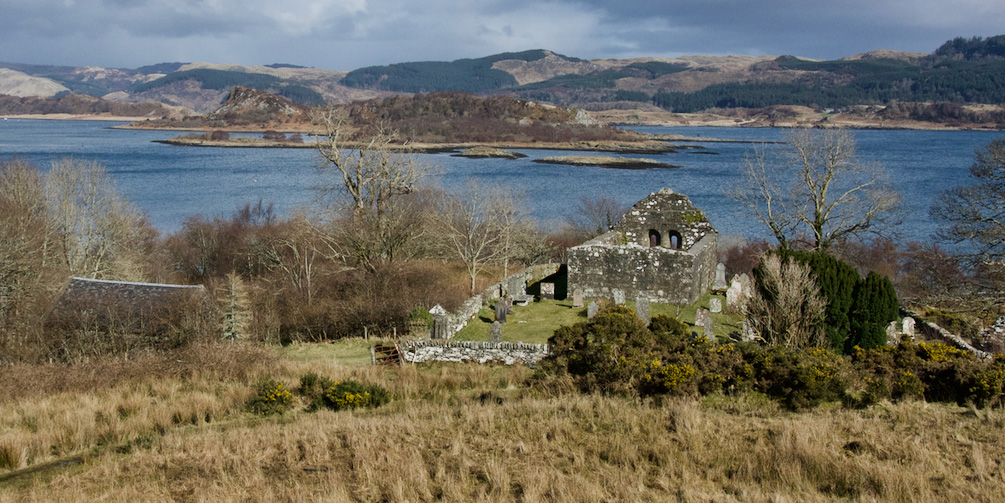
The old chapel of Kilvaree
Towards the bottom of the Craignish peninsula, but not quite at the tip of it, lies an old ruined chapel. Rather confusingly, it bears several names, including Kirkton, Kilvaree, Kilmolroy, and Kilmory. While the first has a Norse element in ‘kirk’, the last three are Gaelic, and come from the same saint-name: St Máel Ruba or Maelrubha of Applecross, a 7th century missionary of Irish descent. ‘Rubha’ means ‘red’, suggesting that this wandering missionary may have been red-haired.
We ventured down there one day at the end of March, when the landscape was still washed in wintry tones of brown. The gorse was coming into flower, but snow lay on the mountains of Mull to the west, and a keen wind was whipping down the loch.
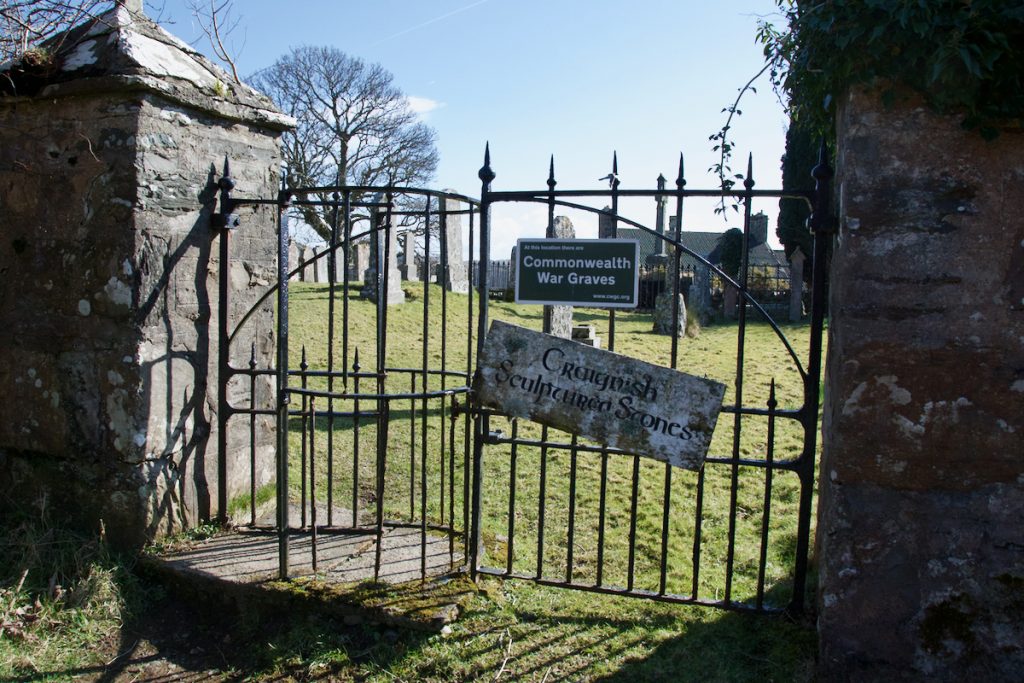 The old painted sign on the gate said ‘Sculptured Stones’, which was promising, so I wandered around to the entrance of the chapel and stepped inside. The building is roofless, but a shelter has been erected over the western end, and a number of medieval gravestones are leaning against the walls. In the grassy nave, recumbent stones are embedded in the grass, and flanking the side walls are four tomb-chests with elaborate carving and broken lids. Upright gravestones mark more recent burials; around these, clumps of snowdrops were flowering, and daffodils were in bud.
The old painted sign on the gate said ‘Sculptured Stones’, which was promising, so I wandered around to the entrance of the chapel and stepped inside. The building is roofless, but a shelter has been erected over the western end, and a number of medieval gravestones are leaning against the walls. In the grassy nave, recumbent stones are embedded in the grass, and flanking the side walls are four tomb-chests with elaborate carving and broken lids. Upright gravestones mark more recent burials; around these, clumps of snowdrops were flowering, and daffodils were in bud.
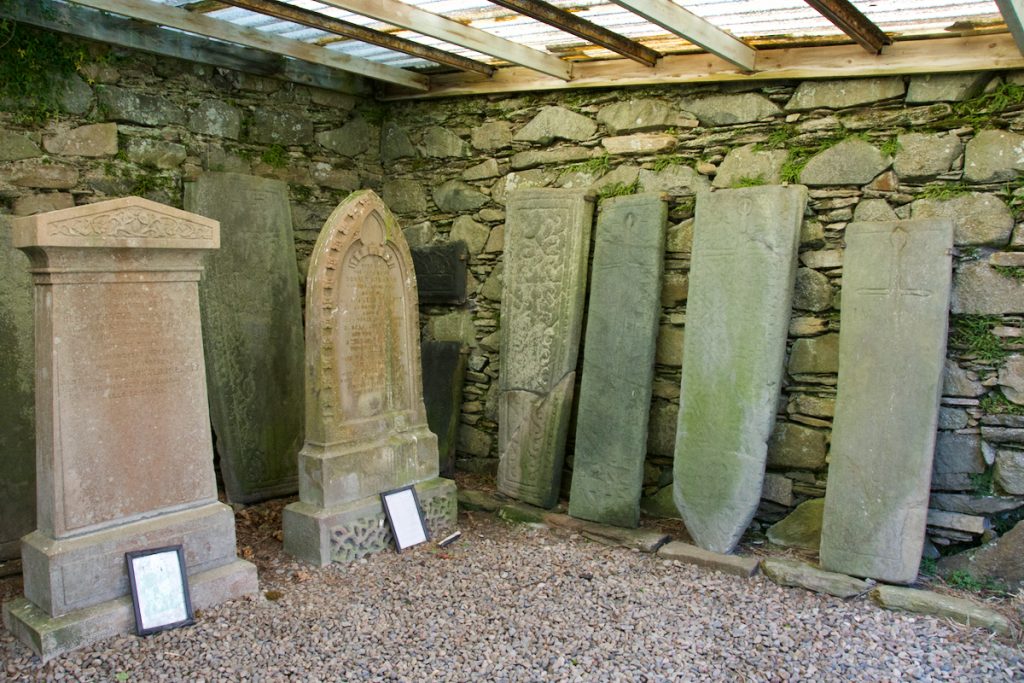
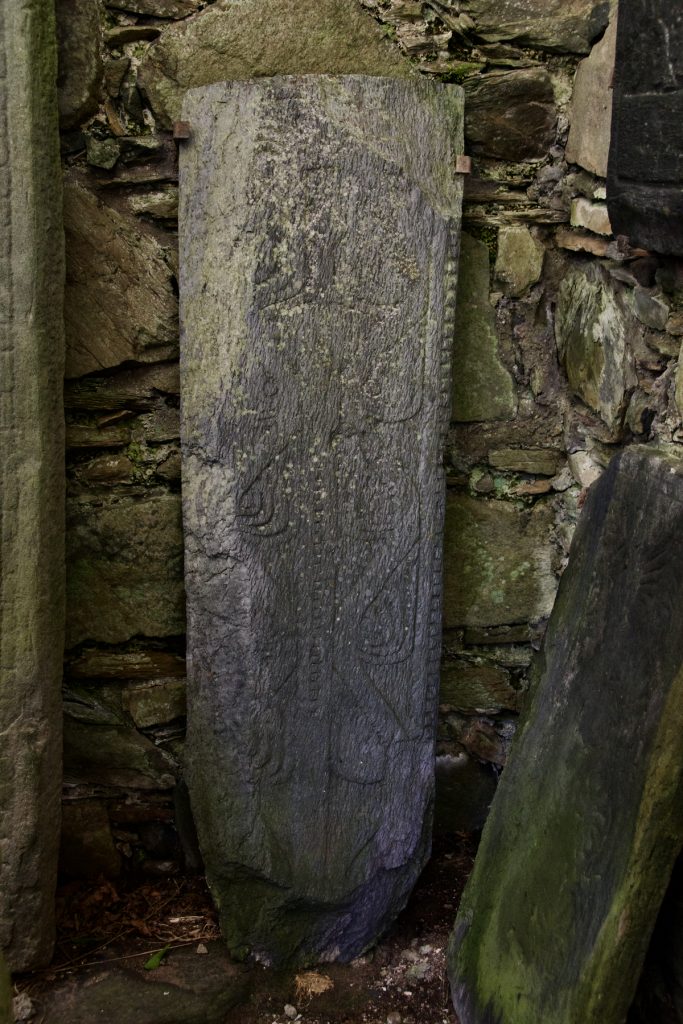
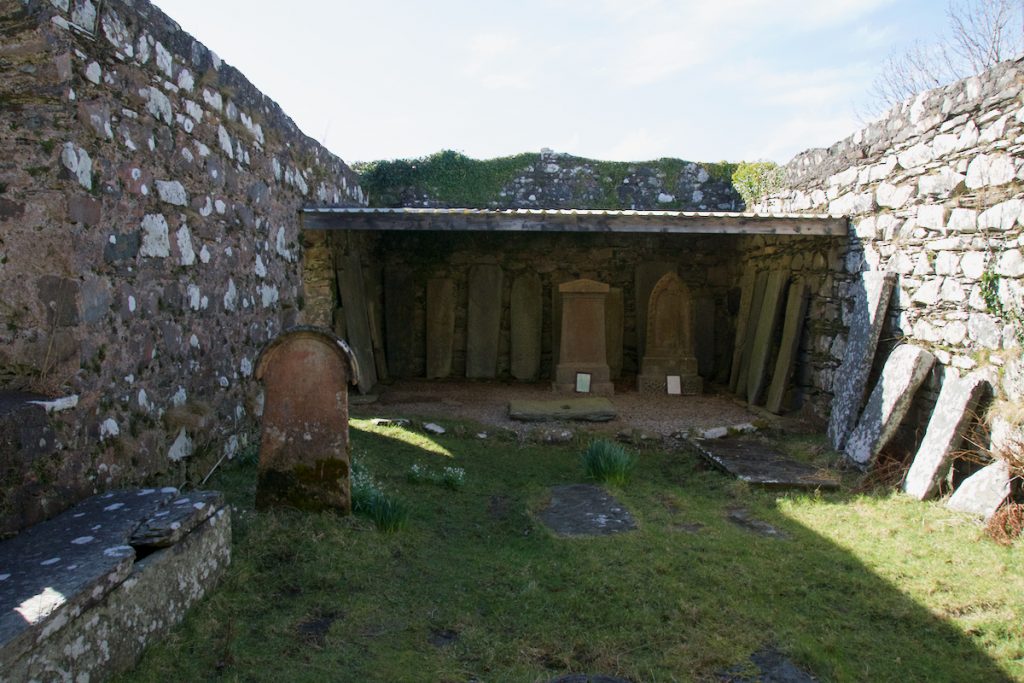
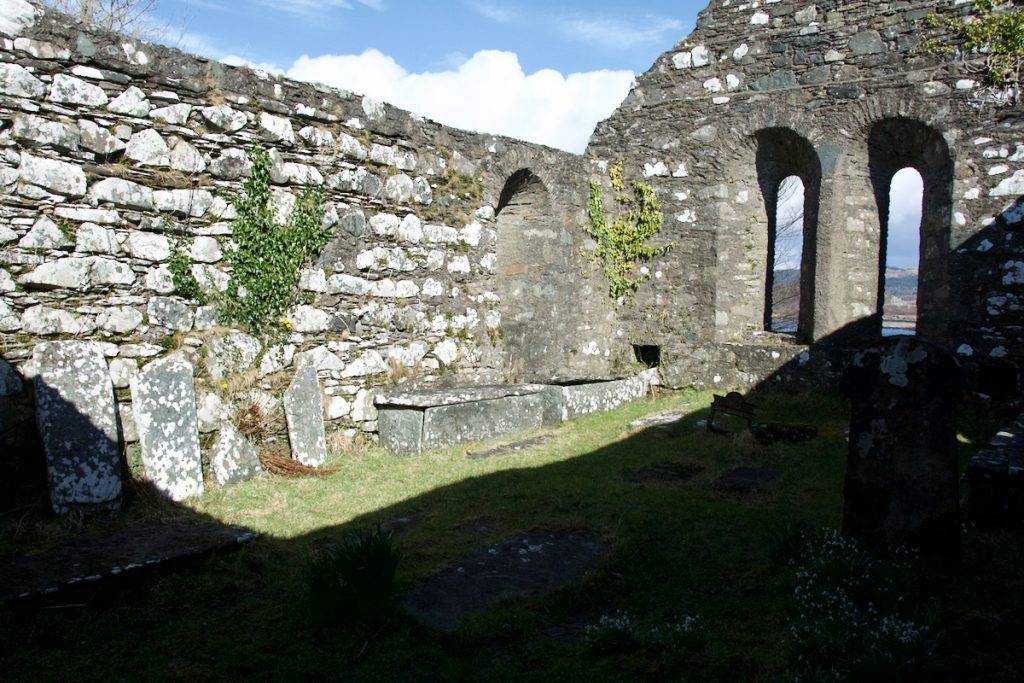
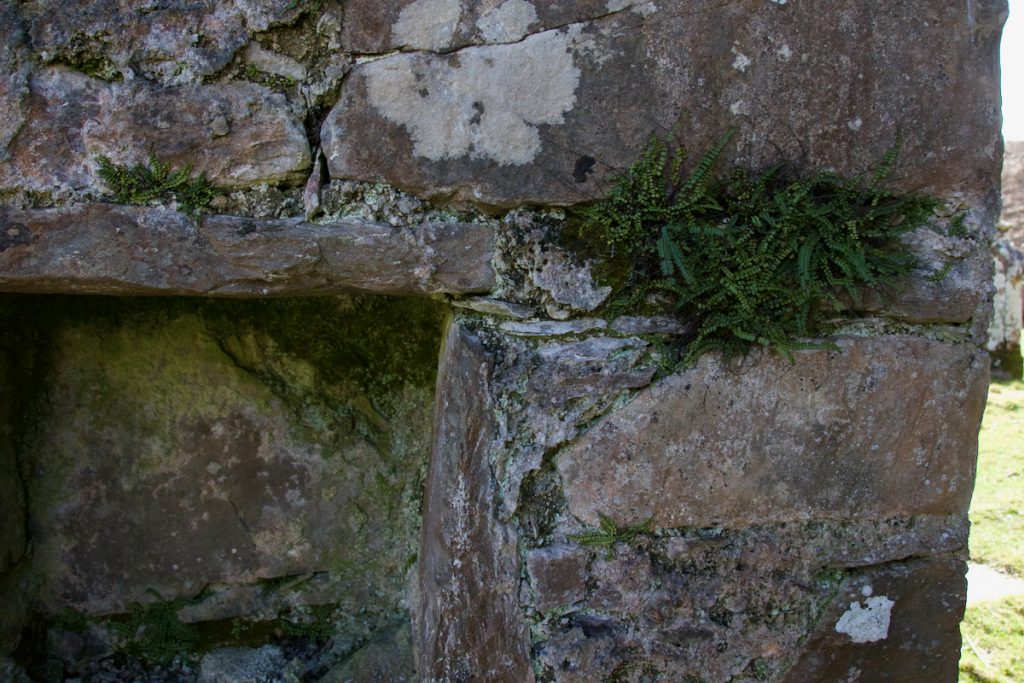
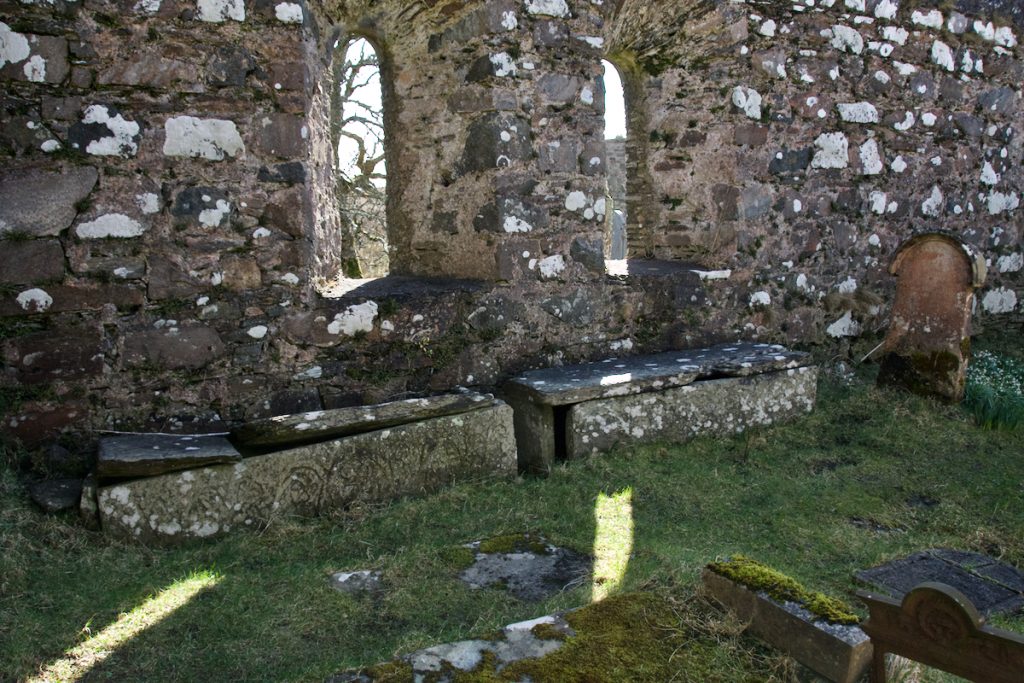 Tomb-chests: the names of those buried here are lost to history
Tomb-chests: the names of those buried here are lost to history
According to the information signs, the stones at the west end were all carved locally, and date from the 15th or 16th century; one smaller stone, immediately by the door, bears a much-eroded simple cross and could be several hundred years older. All these stones once covered the graves of local men and their families. They are decorated with swords and figures of warriors in armour, surrounded by elaborate patterns and knotwork – fine tributes to status and valour in battle.
Lying on the ground was an intriguing flat stone with a slot in it and the faint trace of a sundial carved on its surface; I learned that this was the base for a freestanding cross, which I imagine might have been similar to the ones at Kilmory Knap and Ardchattan. I assume that this one has sadly been lost.
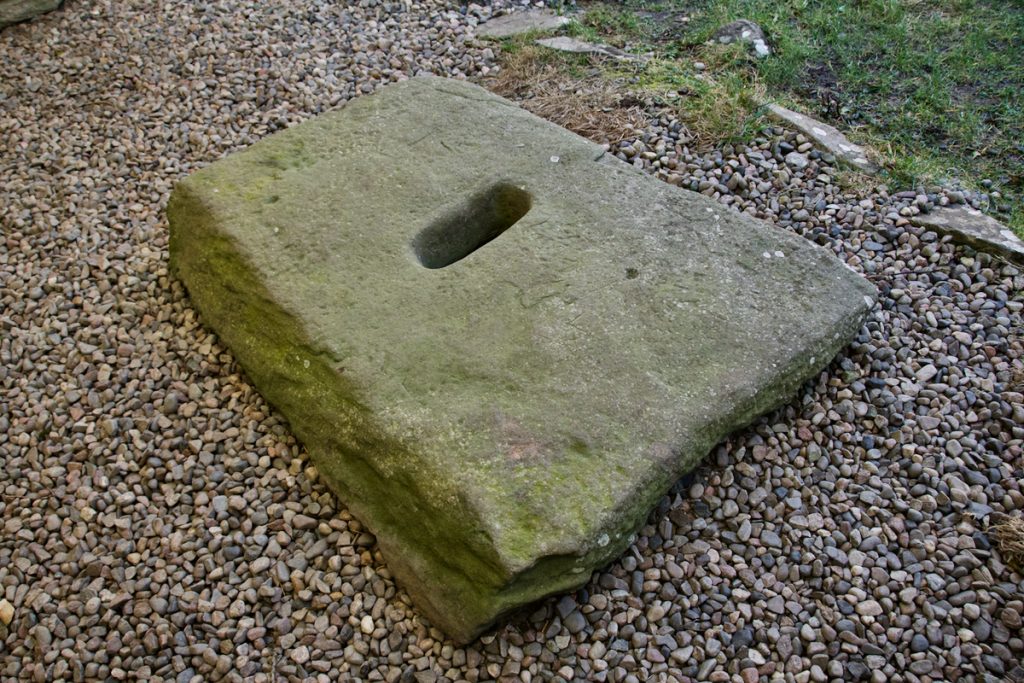 Kilvaree (I’ll use the local name as it’s less confusing) is thought to date from around 1200, and it is built along the lines of other chapels from the same era that are dotted around the west coast of Argyll – simple, rectangular, with narrow arched windows. There are aumbries or small alcoves on either side of where the altar once stood. I’m guessing that the roof would have originally been of turf or thatch, and the walls possibly lime-harled. The surrounding graveyard is enclosed by a stone wall, and the whole site has sweeping views across Loch Craignish.
Kilvaree (I’ll use the local name as it’s less confusing) is thought to date from around 1200, and it is built along the lines of other chapels from the same era that are dotted around the west coast of Argyll – simple, rectangular, with narrow arched windows. There are aumbries or small alcoves on either side of where the altar once stood. I’m guessing that the roof would have originally been of turf or thatch, and the walls possibly lime-harled. The surrounding graveyard is enclosed by a stone wall, and the whole site has sweeping views across Loch Craignish.
St Maelrubha and Kilvaree
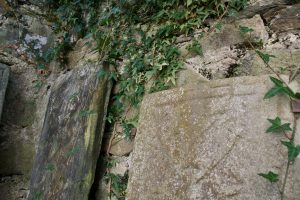 There are chapels dedicated to St Maelrubha in Ross-shire, Sutherland, Skye, Banffshire, Fife, and Kintyre. This suggests that he must have done a lot of travelling, but perhaps his reputation preceded him: one source describes him as ‘the most popular Celtic saint in Scotland’. He is known as St Maelrubha of Applecross, because this is where he established a monastery.
There are chapels dedicated to St Maelrubha in Ross-shire, Sutherland, Skye, Banffshire, Fife, and Kintyre. This suggests that he must have done a lot of travelling, but perhaps his reputation preceded him: one source describes him as ‘the most popular Celtic saint in Scotland’. He is known as St Maelrubha of Applecross, because this is where he established a monastery.
The ‘kil’ or ‘cille’ element of the place-name means ‘cell’, as in a hermit’s cell, which has often evolved into a church. The second part, in all its variations, shows how the name of Maelrubha has been pronounced over the centuries. I would say that ‘Kilvaree’ is a phonetic spelling.
From Saints in Scottish Place-names, here are some variants:
Kilmolroy – 1581, RMS*
Kilmolrow – 1617, RMS*
Kilmolrou – 1654, Blaeu
Cill Mairi – 1875, Ordnance Survey
*RMS: Registrum magni sigilli, or Register of the Great Seal of Scotland
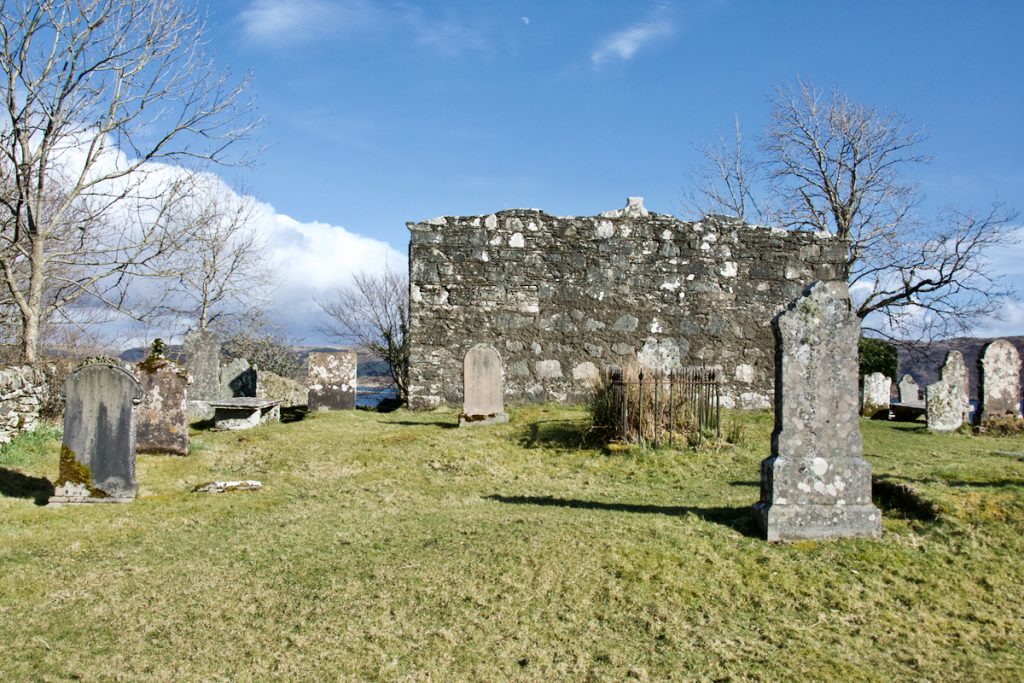 Among the local families buried at Kilvaree are Campbells, MacDougalls, and McLartys
Among the local families buried at Kilvaree are Campbells, MacDougalls, and McLartys
In 1692 the chapel was abandoned in favour of a preaching house at Ardfern, located where the current church now stands. However, burials still take place in Kilvaree’s quiet graveyard.
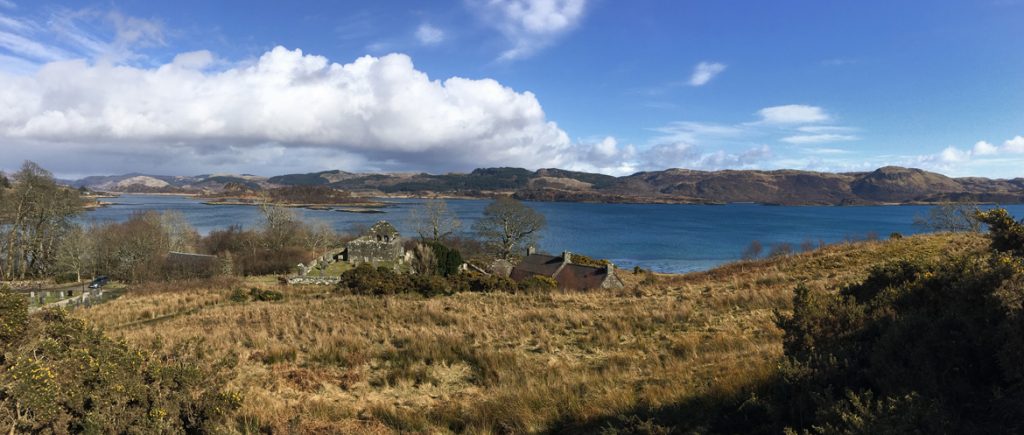 From here, the narrow road winds its way south and west, following the shore of Loch Craignish past cottages with pretty gardens, and curving around pebbly beaches fringed with ash, birch, rowan and hazel. Down on the windswept tip is an old jetty with an abandoned storehouse, the headland giving fine views across to the islands in the west. There are few trees down here, and even the turf has been whipped and sculpted around the underlying rocks to create strange shapes. On most days you can expect to have your hair wildly re-arranged.
From here, the narrow road winds its way south and west, following the shore of Loch Craignish past cottages with pretty gardens, and curving around pebbly beaches fringed with ash, birch, rowan and hazel. Down on the windswept tip is an old jetty with an abandoned storehouse, the headland giving fine views across to the islands in the west. There are few trees down here, and even the turf has been whipped and sculpted around the underlying rocks to create strange shapes. On most days you can expect to have your hair wildly re-arranged.
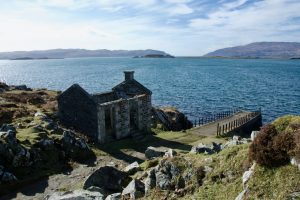 Reference & further reading:
Reference & further reading:
- Canmore database
- Saints in Scottish Place-names
- Craignish local website
- Undiscovered Scotland: Kilvaree
- Undiscovered Scotland: biography of St Maelrubha
- Historic Environment Scotland
- Scottish Churches
‘The Craignish Men of Argyll’s 1685 Uprising’: For an interesting in-depth history of some Craignish families and their involvement in a 17th century uprising, take a look at this post by Colin MacDonald, whose McLarty ancestors are buried at Kilvaree.
You might have noticed that there was another sign on the gate, saying ‘Commonwealth War Graves’. The two recorded graves at Kilvaree are listed on the website of the Commonwealth War Graves Commission.
More chapels with sculptured stones:
Kilmory Knap
Keills, Knapdale
Ardchattan Priory on Loch Etive
Kilberry
Photos copyright © Jo Woolf

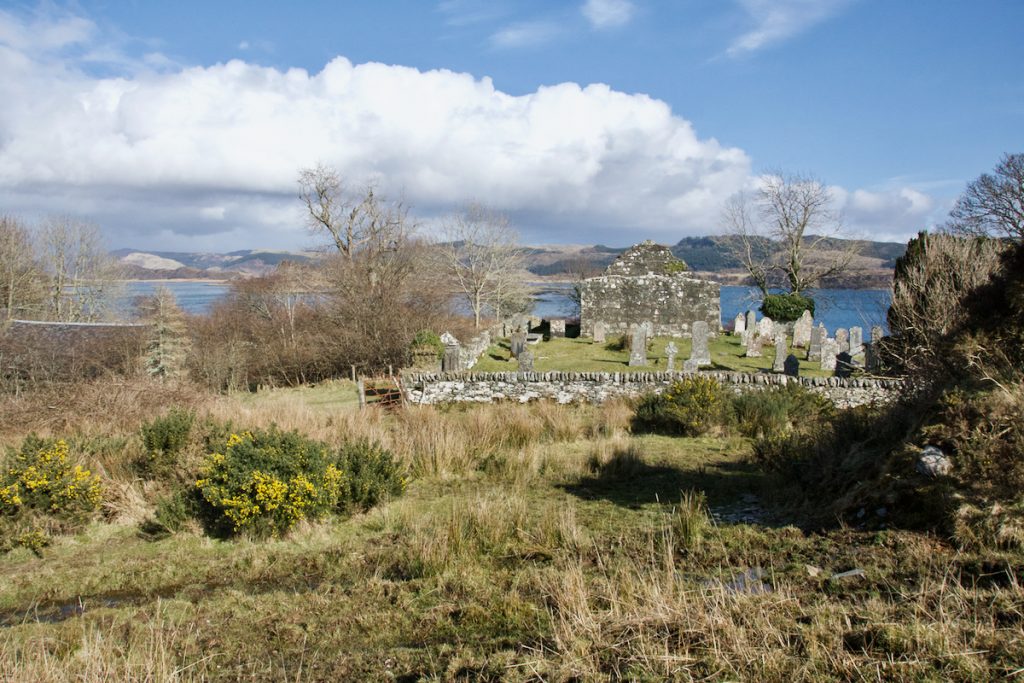
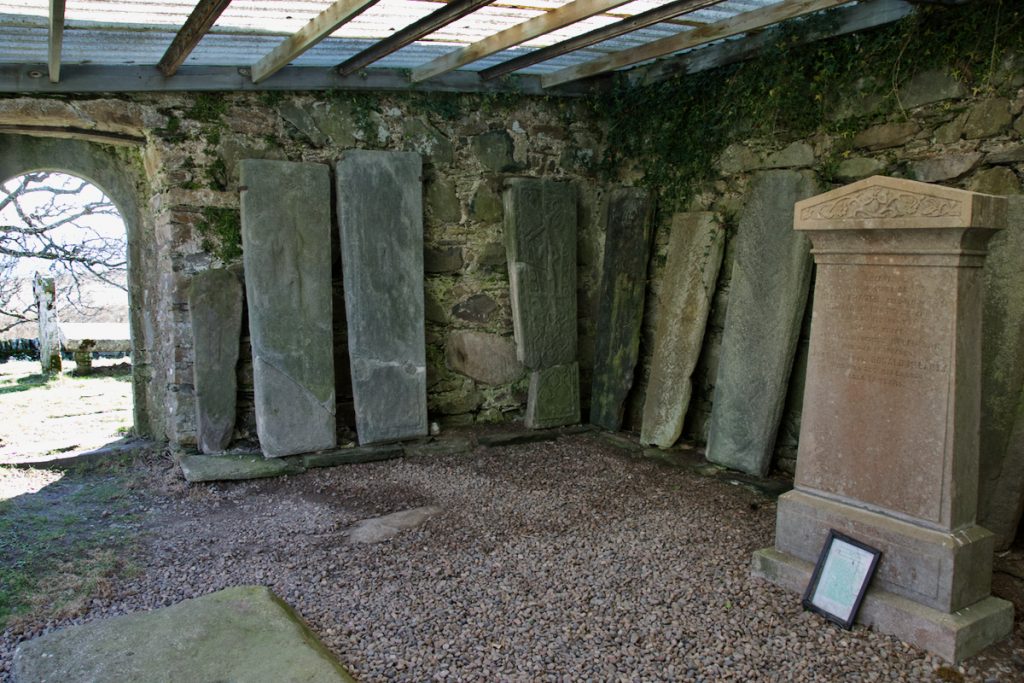
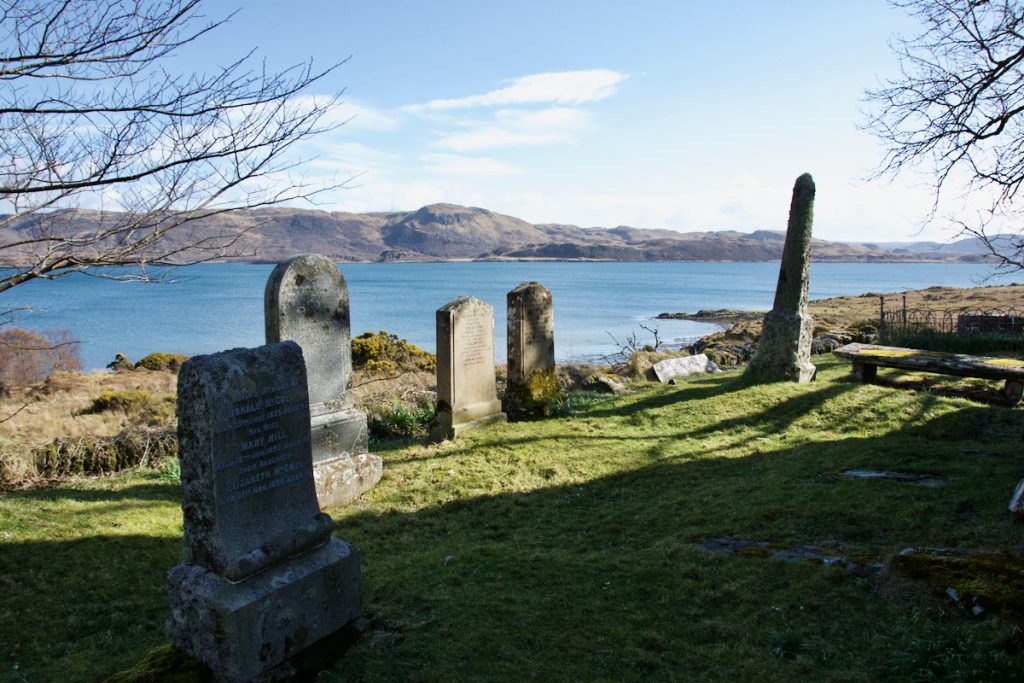
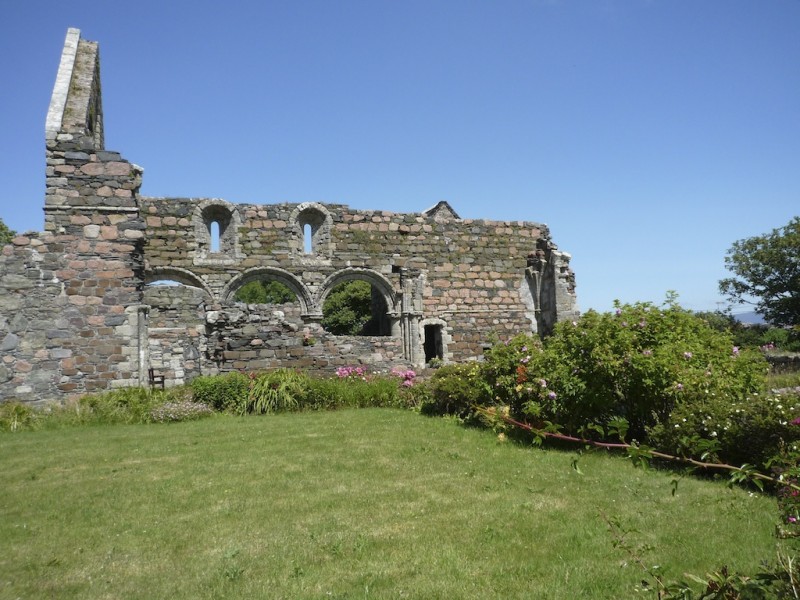
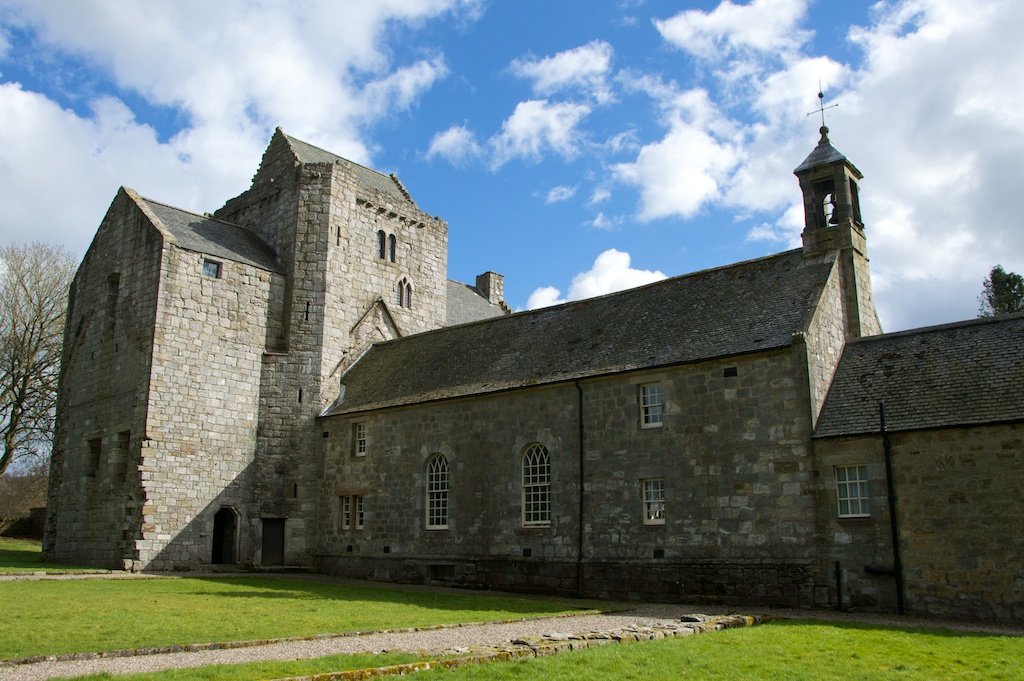
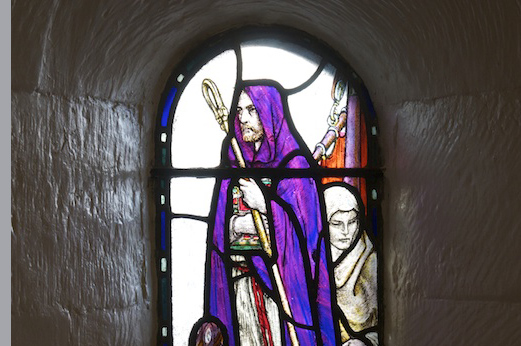
18 Comments
John Seddon
Hi Jo,
Another interesting piece.
I think the Gaelic for red is dearg and rubha is a promontary or point of land, but am open to correction. If I am correct it maybe referred to a large nose!?
Gaelic eh! Who’d av em.
Regards,
John.
Jo Woolf
Thanks, John! 🙂 I think ‘ruadh’ might mean ‘red’ or specifically ‘red-haired’, and ‘dearg’ also means ‘red’! I’m not sure about the point of land or large nose! I need to learn Gaelic! Maybe there are some readers who can help us out…
Colin MacDonald
I enjoyed this post, thanks Jo. Kilvoree/Kirkton is a real treasure, isn’t it?
I’ve longed dreamed of buying the neighbouring farmhouse and restoring it. Alas I am not a wealthy man, at least not in financial terms!
If you haven’t visited it already, there is another local cemetery which may be of interest. When you turn from the main road (A816) towards the peninsula (B8002) there is a small parking bay immediately on the left. If you park there and cross the road there is a track that winds its way around to a very old graveyard, hidden away in the trees. It was extremely muddy last time I visited so wellies are probably required.
When I was there in 2015 it was overrun with vegetation and I wondered if the council had given up on it. The cemetery must have been in use up until fairly recent times as a cousin of my Gran was buried there (Helen Fraser McLarty, Granddaughter of the Donald McLarty buried in Kilvoree and known locally as Mrs Shaw).
Jo Woolf
It certainly is a treasure, Colin! We saw it again today, as we went over to Craignish Village Hall and then went on down the road a bit, to potter around a couple of the beaches. Everything so lush – all the grass verges are now overflowing with flowers. Keep dreaming about the farmhouse, you never know what’s around the corner! I shall look up the graveyard – thank you, that sounds very interesting. I think I know where you mean but will look it up on a map.
montucky
What a wonderful place and a spectacular location. There’s so much history there: it stirs the imagination!
Jo Woolf
Yes, it’s such a lovely place and it could tell so many stories! I love finding little places like this, off the beaten path.
davidoakesimages
No matter how often one visits an area you always miss something…good excuse to return. Last September we visited Kilmory Knap Church. Love the innovative conservation idea of a glass roof, it works so well….all the more so as it was a real wet Argyll day. If you click this link you can see may blog of that visit :- https://davidoakesimages.wordpress.com/2017/10/08/silent-sunday-so-off-to-a-church-again/
Jo Woolf
I know, David – places keep popping up every time I look at a map! Love your photos of Kilmory Knap, you have really captured the beauty of the stones.
Lorna
You’re very good at finding these old graveyards, and these are some lovely photos. It’s interesting that people are still buried there to this day, because it looks so old and well settled in, if you know what I mean. It’s certainly a beautiful and peaceful-looking spot to choose as a final resting place.
Jo Woolf
Thanks, Lorna. Yes, they seem to leap out of the map at me! It must be the antiquated font they use! 😀 It’s a lovely old place, so secluded and peaceful. There is also a more modern graveyard plot across the lane from the chapel car park – in the last but one photo (panorama) it’s just visible on the far left.
greg-in-washington
Looks like taking the road less travelled pays off in the discovery of new things–new to me anyway. Love the photos.
Jo Woolf
Thank you. Yes, always worth taking those winding little roads!
simonjkyte
ruadh is on the same root as English RED and Greek ERYTHROS.
Jo Woolf
That’s interesting! Thank you for that.
Sandra
Such a beautiful spot. A wonderful resting place in every sense.
Jo Woolf
Yes, very true – hard to imagine a more beautiful, peaceful place.
Jim Rule
Jo: Have you ever been down to Rule Water on the Borders south of Jedburgh? Beautiful country from whence my family came. In ancient Celtic rule means ‘roaring in haste’ ….an apt family motto! Flows into the Teviot. Can send you some pictures from a recent trip.
Jo Woolf
Hi Jim, No, that’s not a part of Scotland I know very well at all. I love your family motto! 🙂 Would love to see pics if you would like to share them. Feel free to send them to jo(at)thehazeltree.co.uk or if you’d like to share them publicly, you could put them on my Facebook page (link at the bottom of the page). Best wishes, Jo